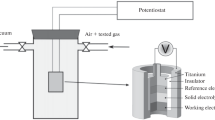Abstract
Application of solid electrolytes as undergate layers accelerates the response of a sensor at room temperature as compared with ordinary hydrogen sensors manufactured on the basis of the metal-insulator-semiconductor (MIS) structures with a palladium gate. The proton-conducting solid electrolytes under study include NAFION, zirconium hydrophosphate, and etherified polyvinyl alcohol (PVA) with heteropolyacids and phenoldisulfonic acid, which can be deposited under the platinum gate. Sensors based on the MIS structures with these solid electrolytes show a high sensitivity toward hydrogen (∼120 mV per concentration decade). The response time τ0.63 of a freshly manufactured sensor with a layer of zirconium hydrophosphate amounts to about 2 min. The maximum mechanical stability, especially at relative humidities in excess of 80% is intrinsic to sensors containing layers of PVA with heteropolyacids. The response time of such sensors is nearly 10 min.
Similar content being viewed by others
References
Moritz, W., Krause, S., Vasiliev, A.A., Godovski, D., and Malyshev, V., Abstracts of Papers, 5th Int. Meet. on Chem. Sensors, Rome, 1994, p. 242.
Moritz, W., Bartholomeus, L., Roth, V., Filippov, V., Vasiliev, A.A., and Terentjev, A., Anal. Chem. Acta, 1999, vol. 393, p. 49.
Vasiliev, A.A., Filippov, V.I., Moritz, W., and Szeponik, J., Chem. Sens., 2004, vol. 20,suppl. B, p. 414.
Vasiliev, A.A., Moritz, W., Filippov, V., Alberti, G., and Palombari, R., Abstracts of Papers, Eurosensors XVII, Rome, 2004, p. 644.
Vasiliev, A.A. and Moritz, W., Abstracts of Papers, 9th Int. Meet. on Chem. Sensors, Boston, 2002, p. 233.
Vasiliev, A.A., Lyutikova, E.K., Filippov, V.I., and Morits, V., Sensor, 2002, no. 4, p. 8.
Miura, N., Harada, T., Yoshida, N., Shimizu, Y., and Yamazoe, N., Sens. Actuators B, 1995, vol. 25, p. 499.
Alberti, G. and Casciola, M., Solid State Ionics, 2001, vol. 145, p. 3.
Author information
Authors and Affiliations
Additional information
Original Russian Text © A.A. Vasiliev, V.I. Filippov, Yu.A. Dobrovolsky, A.V. Pisareva, W. Moritz, R. Palombari, 2007, published in Elektrokhimiya, 2007, Vol. 43, No. 5, pp. 593–601.
Based on the paper delivered at the 8th Meeting “Fundamental Problems of Solid-State Ionics”, Chernogolovka (Russia), 2006.
Rights and permissions
About this article
Cite this article
Vasiliev, A.A., Filippov, V.I., Dobrovolsky, Y.A. et al. Hydrogen sensors based on metal-insulator-semiconductor structures with a layer of a proton-conducting solid electrolyte. Russ J Electrochem 43, 561–569 (2007). https://doi.org/10.1134/S1023193507050096
Received:
Issue Date:
DOI: https://doi.org/10.1134/S1023193507050096




